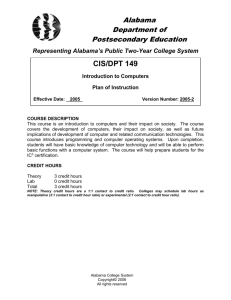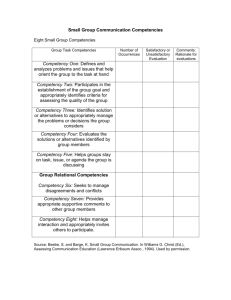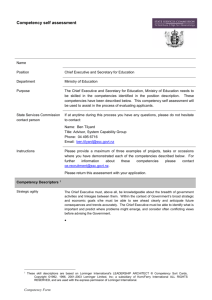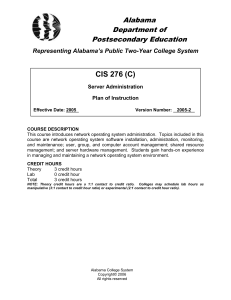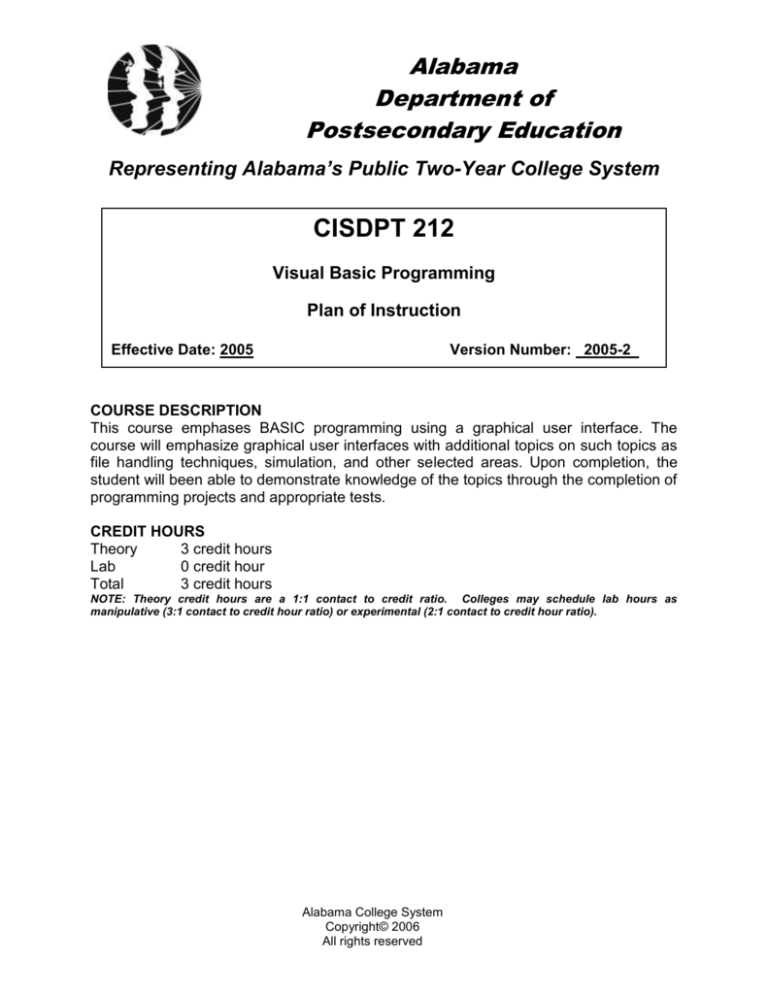
Alabama
Department of
Postsecondary Education
Representing Alabama’s Public Two-Year College System
CISDPT 212
Visual Basic Programming
Plan of Instruction
Effective Date: 2005
Version Number: 2005-2
COURSE DESCRIPTION
This course emphases BASIC programming using a graphical user interface. The
course will emphasize graphical user interfaces with additional topics on such topics as
file handling techniques, simulation, and other selected areas. Upon completion, the
student will been able to demonstrate knowledge of the topics through the completion of
programming projects and appropriate tests.
CREDIT HOURS
Theory
3 credit hours
Lab
0 credit hour
Total
3 credit hours
NOTE: Theory credit hours are a 1:1 contact to credit ratio. Colleges may schedule lab hours as
manipulative (3:1 contact to credit hour ratio) or experimental (2:1 contact to credit hour ratio).
Alabama College System
Copyright© 2006
All rights reserved
Visual Basic Programming
CIS 212
PREREQUISITE COURSES
Determined by college unless stated otherwise
CO-REQUISITE COURSES
Determined by college unless stated otherwise
PROFESSIONAL COMPETENCIES:
Explain visual basic.
Design a user interface.
Perform various calculations using visual basic programming.
Develop a visual basic program that makes decisions.
Develop a visual basic program that utilizes iteration structure.
Develop a visual basic program that utilizes functions and procedures.
Develop a visual basic program that utilizes data structures.
Develop a visual basic program that utilizes error handling.
GENERAL INSTRUCTIONAL OBJECTIVES:
The cognitive objective for this course is for students to comprehend foundational
knowledge of visual basic programming.
The performance objective of this course is for students to apply foundational
knowledge of visual basic programming.
PROFESSIONAL COMPETENCIES/OBJECTIVES:
Unless otherwise indicated, evaluation of student’s attainment of cognitive and
performance objectives is based on knowledge gained from this course. Specifications
may be in the form of, but not limited to, certification agencies, national and state codes,
facility policies, locally developed lab/clinical assignments, or any combination of
specifications.
ACS Copyright© 2006
All rights reserved
2
Visual Basic Programming
CIS 212
MODULE A – INTRODUCTION TO VISUAL BASIC
PROFESSIONAL COMPETENCIES
A1.0 Explain visual basic. (B)
PERFORMANCE OBJECTIVES
This competency is measured cognitively.
KSA
ENABLING OBJECTIVES
Indicators
A1.1.1 Define terms associated with visual basic programming.
A
A1.1.2 Explain event driven object-oriented programming.
B
A1.1.3 Differentiate between procedural and object oriented programming.
B
A1.1.4 List the uses of visual basic programming.
A
A1.1.5 Explain IDE.
A
A1.1.6 Explain syntax.
A
MODULE B – DESIGNING A USER INTERFACE
PROFESSIONAL COMPETENCIES
B1.0 Design a user interface. (3c)
PERFORMANCE OBJECTIVES
B1.1 Create a user interface and test for proper
operation.
KSA
ENABLING OBJECTIVES
Indicators
B1.1.1 Explain the concept of an object.
B
B1.1.2 Explain how to design forms.
b
B1.1.2 Explain how to place controls on forms.
b
B1.1.3 Explain how to set properties.
b
B1.1.4 Explain methods.
B
B1.1.5 Explain events and how they trigger actions.
c
B1.1.6 Describe input and output controls.
B
B1.1.7 Explain common interface design guidelines.
B
MODULE C – CALCULATIONS
PROFESSIONAL COMPETENCIES
C1.0 Perform various calculations
using visual basic programming.
(3c)
PERFORMANCE OBJECTIVES
C1.1 Develop and debug a visual basic program
that performs calculations.
ENABLING OBJECTIVES
C1.1.1
C1.1.2
C1.1.3
C1.1.4
C1.1.5
Define data types.
Define variables and constants.
Explain the correct sequence of mathematical operations.
Explain logical and syntax debugging.
Explain intrinsic functions.
ACS Copyright© 2006
All rights reserved
KSA
Indicators
A
c
c
d
b
3
Visual Basic Programming
CIS 212
MODULE D – DECISION MAKING
PROFESSIONAL COMPETENCIES
D1.0 Develop a visual basic program
that makes decisions. (3c)
PERFORMANCE OBJECTIVES
D1.1 Develop and debug a visual basic program
that utilizes decision structures.
KSA
ENABLING OBJECTIVES
Indicators
D1.1.1 Describe if statements.
B
D1.1.2 Describe nested if statements.
B
D1.1.3 Describe select case structure.
c
D1.1.4 Explain relational operators.
c
D1.1.5 Explain logical operators.
c
MODULE E – ITERATION
PROFESSIONAL COMPETENCIES
E1.0 Develop a visual basic program
that utilizes iteration structure.
(3c)
PERFORMANCE OBJECTIVES
E1.1 Develop and debug a visual basic program
that utilizes iteration structure.
ENABLING OBJECTIVES
E1.1.1 Explain loop structures.
E1.1.2 Explain loop structures.
E1.1.3 Differentiate between counters and accumulators.
KSA
Indicators
B
c
c
MODULE F – FUNCTIONS AND PROCEDURES
PROFESSIONAL COMPETENCIES
F1.0 Develop a visual basic program
that utilizes functions and
procedures. (3c)
PERFORMANCE OBJECTIVES
F1.1 Develop and debug a visual basic program
that utilizes functions and procedures.
ENABLING OBJECTIVES/KEY INDICATORS
F1.1.1 Explain user defined functions.
F1.1.2 Describe parameters.
F1.1.3 Differentiate between passing parameters by value or by
reference.
ACS Copyright© 2006
All rights reserved
KSA
Indicators
c
B
c
4
Visual Basic Programming
CIS 212
MODULE G – DATA STRUCTURES
PROFESSIONAL COMPETENCIES
G1.0 Develop a visual basic program
that utilizes data structures. (3c)
ENABLING OBJECTIVES
G1.1.1
G1.1.2
G1.1.3
G1.1.4
Describe arrays.
Describe strings.
Describe abstract data types.
Describe classes.
STUDENT PERFORMANCE OBJECTIVES
G1.1 Develop and debug a visual basic program
that utilizes data structures.
KSA
Indicators
c
c
c
c
MODULE H – ERROR HANDLING
PROFESSIONAL COMPETENCIES
H1.0 Develop a visual basic program
that utilizes error handling. (3c)
STUDENT PERFORMANCE OBJECTIVES
H1.1 Develop and debug a visual basic program
that utilizes error handling.
KSA
ENABLING OBJECTIVES
Indicators
H1.1.1 Describe types of errors.
b
H1.1.2 Describe error handling methods.
c
ACS Copyright© 2006
All rights reserved
5
Visual Basic Programming
CIS 212
COURSE CONTENT OUTLINE
MODULE A – INTRODUCTION TO VISUAL BASIC
Terms and definitions
Review design applications
Event driven object-oriented programming
Uses for Visual Basic Programming
Integrated Development Environment (IDE)
Syntax
MODULE B – DESIGNING A USER INTERFACE
Objects
Forms
Controls
Properties
Methods
Events
Input/output
Interface design guidelines
MODULE C – CALCULATIONS
Data types
Variables and constants
Mathematical operations
Debugging
Intrinsic functions
MODULE D – DECISION MAKING
If statements
Select case
Relational operators
Logical operators
MODULE E – ITERATION
Looping structures
Do loops
Pretest/Post test
For loops
Counters
Accumulators
ACS Copyright© 2006
All rights reserved
6
Visual Basic Programming
CIS 212
MODULE F – FUNCTIONS AND PROCEDURES
User defined functions
Parameters
By value
By reference
MODULE G – DATA STRUCTURES
Arrays
Strings
Abstract data types
Classes
MODULE H – ERROR HANDLING
Types of errors
Error handling methods
ACS Copyright© 2006
All rights reserved
7
Visual Basic Programming
CIS 212
RECOMMENDED METHODS OF EVALUATION: The tables of specifications below
identify the number of cognitive (knowledge) enabling objectives, psychomotor
(performance) objectives, and affective (attitudinal) objectives per module. Instructors
should develop sufficient numbers of test questions to ensure complete coverage of
each cognitive and/or psychomotor objective identified in each module. For cognitive
objectives, use appropriate written test type based on the complexity indicator for each
objective. Create comprehensive, checklist evaluations for each psychomotor objective.
Facts/Nomenclature (A/a):
Multiple Choice, Fill-in, List, Matching, Alternative
Response (true/false or yes/no)
Principles/Procedures (B/b): Multiple Choice, Fill-in, List, Short Answer
Analysis/Operating Principles (C/c): Multiple Choice, Short Answer, Essay
Evaluation/Complete Theory (D/d): Multiple Choice, Short Answer, Essay
ENABLING OBJECTIVES TABLE OF SPECIFICATIONS
Cognitive Domain
Facts/
Nomenclature
Principles/
Procedures
4
1
5
2
7
2
2
1
1
1
16
Module A
Module B
Module C
Module D
Module E
Module F
Module G
Module H
Total
Analysis/
Operating
Principles
1
2
3
2
2
4
1
15
Evaluation/
Complete
Theory
0
Total
6
8
5
5
3
3
4
2
36
PERFORMANCE OBJECTIVES TABLE OF SPECIFICATIONS
Psychomotor Domain
Module A
Module B
Module C
Module D
Module E
Module F
Module G
Module H
Total
ACS Copyright© 2006
All rights reserved
Limited
Proficiency
(Level 1)
0
Partially
Proficient
(Level 2)
0
Proficient
(Level 3)
1
1
1
1
1
1
1
7
Highly
Proficient
(Level 4)
-
Total
0
1
1
1
1
1
1
1
7
8
Visual Basic Programming
Knowledge, Skills, and Attitudes (KSA) Indicators
Key Word(s)
Definition
Highly
Performs competency quickly and accurately. Instructs others how to do
Proficient
the competency.
Performs all parts of the competency. Needs only a spot check of
Proficient
completed work.
Partially
Performs most parts of the competency. Needs help only on hardest parts.
Proficient
Performs simple parts of the competency. Needs to be told or shown how
Limited Proficiency
to do most of the competency.
Complete
Predicts, isolates, and resolves problems about the competency.
Theory
Operating
Identifies why and when the competency must be done and why each step
Principles
is needed.
Procedures
Determines step-by-step procedures for doing the competency.
Nomenclature
Names parts, tools, and simple facts about the competency.
Evaluation
Evaluates conditions and makes proper decisions about the subject.
Analysis
Analyzes facts and principles and draws conclusions about the subject.
Identifies relationship of basic facts and states general principles about the
Principles
subject.
Value
Performance
Ability
4
3
2
Knowledge
Knowledge of
Skills
1
Affective
CIS 212
d
c
b
a
D
C
B
A
Facts
*5
Characterization by
Value
*4
Organization
*3
Valuing
*2
Responding
*1
Receiving
Identifies basic facts and terms about the subject.
Acting consistently with the new value
Integrating a new value into one's general set of values, giving it some
ranking among one's general priorities
Showing some definite involvement or commitment
Showing some new behaviors as a result of experience
Being aware of or attending to something in the environment
Alpha Scale Values - Any item with an upper case letter (A, B, C, D) by itself is taught as general information on a topic. This information may be related to the
competency or encompass multiple competencies. Examples might include mathematical computations or knowledge of principles such as Ohm’s Law.
A lower case letter indicates a level of ”Knowledge of Skills." Individuals are taught information pertaining to performing a competency . These may be indicated
alone or in conjunction with a numerical scale value. A lower case letter by itself indicates the individual is not required to perform the task-just know about the task.
(example: Can state or explain procedures for doing a task).
Numerical Scale Values - The numbers reflect the levels the individual will be able to perform a competency. Number values are always accompanied by lower
case letters (i.e. 1a, 2b, 3c...etc.) in order to specify the level of knowledge of skills associated with the competency.
Example: An individual with a competency with a scale indicator of 3b has received training of knowledge of skills whereby he or she can determine the correct
procedures and perform with limited supervision; only requiring evaluation of the finished product or procedure.
Asterisk items indicate desired affective domain levels and are used to indicate the desired level for a given competency. They may be used independently or with
other indicators (i.e. 1a-*1, 2c-*3). If used with another indicator, separate with a hyphen.
NOTE: Codes indicate terminal values.
ACS Copyright© 2006
All rights reserved
9


